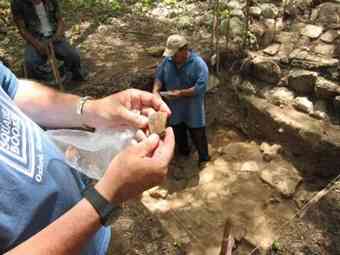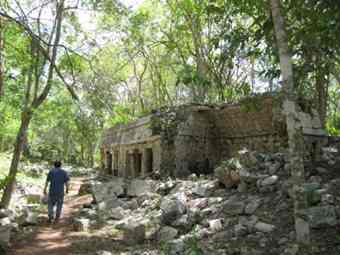Bird calls ring from the forest, echoing amid the crumbling ruins, the darkened doorways of which have long beckoned explorers and scholars.
 The Mayan ancients who built the ruins of Kiuic here fled those doorways in a hurry, an international archaeology team now realizes. Left behind may be frozen-in-time clues to the fabled collapse of their civilization.
The Mayan ancients who built the ruins of Kiuic here fled those doorways in a hurry, an international archaeology team now realizes. Left behind may be frozen-in-time clues to the fabled collapse of their civilization.
“Why did they leave? That's the question,” says archaeologist George Bey of Millsaps College in Jackson, Miss. The ancient Maya fled Kiuic, nestled in the Puuc foothills of the Yucatán, around 880 A.D. “Things were going full-bore, construction was under way. And things stopped,” Bey says.
Archaeologists have explored Kiuic's ruins for more than a century, but working since 2000, Bey and colleagues are now reporting the first evidence of this rapid abandonment. USA Today was invited to the site to see what has been uncovered in the latest excavations.
The “classic” Maya peopled the lowland forests of Central America during Europe's Dark Ages, building a civilization of pyramids, palaces and slash-and-burn “milpa” farms made by burning trees and planting seeds in the ash. Mayan rulers oversaw city-states that warred with one another, created elaborate calendars and lasted centuries. The abandonment of those monument-strewn centers stands as one of archaeology's most-debated mysteries. The “collapse” was under way in modern-day Guatemala by 800, but didn't take place at Kiuic until almost a century later.
Preserved like Pompeii
Farther north, at centers such as Mayapán, pyramids and temples stayed in business until the arrival of Spain's conquistadors in the 1500s. The Mayan people themselves remained, of course, with millions living today in Central America, from modern-day El Salvador to Mexico.
Scholars are entranced with the ruins at Kiuic that still bear the last traces of their owners' flight, a Mayan version of Pompeii, the entombed town of Roman archaeological fame. Overlooked and overgrown for more than a millennium, a variety of clues now beg for interpretation:
 Walls, perfectly laid out with cornerstones and vault stones, lying flat on the ground and waiting to be erected atop the second floor of a palace.
Walls, perfectly laid out with cornerstones and vault stones, lying flat on the ground and waiting to be erected atop the second floor of a palace.
A half-finished plaza, one side stuccoed and completed, the other composed of bowling-ball-sized stones.
Pots and grinding stones left neatly in homes, awaiting their owners' return.
At Kiuic, “the evidence for rapid abandonment now appears more compelling,” says archaeologist Takeshi Inomata of the University of Arizona-Tucson, who heads efforts to investigate the Mayan settlement of Aguateca in Guatemala, a site suddenly abandoned in 830 during warfare. “It is a very important discovery.”
Pumas roam the forest lining the overgrown trail leading out of Kiuic. Stones crumble underfoot on the hillside, threatening to tumble visitors to the forest floor. Once a stair built of the stones, the Escalero al Cielo (Stairway to Heaven) leads to ruins of a temple courtyard and many homes that await 200 feet above.
“The climb kept away looters, and also sometimes older archaeologists,” says Tomás Gallareta Negrón of Mexico's National Institute of Anthropology and History, a co-director of the site with Bey and William Ringle of Davidson (N.C.) College. Gallareta Negrón has pioneered efforts to turn the site into an education center.
Kiuic has been visited by archaeologists since at least 1841, when John Lloyd Stephens, the so-called American Traveler, recorded the site for his “Incidents of Travel in Yucatán,” a best seller of the pre-Civil War era. Some of the ruins he described at that time still stand there, such as the three-story-tall Yaxché pyramid and Kuche palaces.
But the Stairway to Heaven homes high above the site now attract as much, or more, attention from the archaeologists. During excavations last year, archaeologists found pottery and stone tools left in place inside homes, including a wealthy farmer's kitchen room perched on the edge of the hill. Corn-grinding stones called metates still rest on their sides next to doorways, at the ready for preparing another meal.
In June, excavations revealed more pottery left neatly under another collapsed roof in the farmer's home. And under the floor of the main room, researchers found the site of a double burial. “We think these are ancestors of some kind,” a burial arrangement in line with the practices of the ancient Maya, says archaeologist Stephanie Simms of Boston University. “They certainly merited special treatment,” she says, buried with jade beads and stone tools.
Says anthropologist Rani Alexander of New Mexico State University-Las Cruces: “Rapid abandonments are rare finds for archaeologists. The new information at Kiuic offers another take on the Maya collapse.”
Drought, disease, warfare, corn-borers, worn-out soils — almost as many theories as ruins abound to explain the collapse.
So the archaeologists will continue exploring these theories next summer. Residues in the pottery at the Stairway to Heaven should precisely time its abandonment, through carbon dating. Burnt wood left amid the burials should similarly time the site's construction. The team will keep asking questions with each new bit of evidence, aiming to uncover clues to Kiuic's collapse.
Author: Dan Vergano | Source: Courier-Journal [September 06, 2010]





